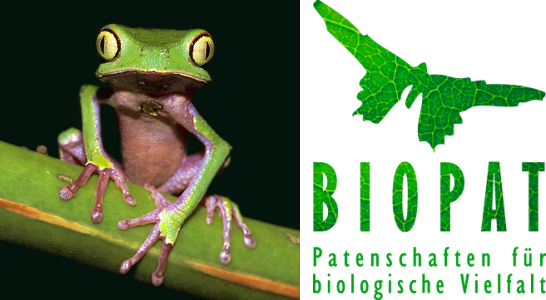Biodiversity
 Micandra stephanieae
Micandra stephanieae
The importance of biodiversity and the impact of "gene erosion"
Life and its extraordinary diversity is a unique asset that sets the earth apart from all the other known planets in the universe. Human beings themselves are part of this huge spectrum of life-forms, and biological diversity (=biodiversity) provides the basis for human existence. It is only in the last few years that the full extent of the earth's diversity has become clear. The 1.8 million or so species of animals and plants currently known to us probably constitute well under 10 per cent of the range of species actually in existence.
At the same time, human beings have become a crucial component of biodiversity. The ever more rapidly increasing world population, and the exploitation of natural resources that goes along with this, have underlined the dramatic transformation which the earth's diversity is undergoing. There have always been times on the earth when large numbers of species have died out. The dinosaurs are a case in point. But what is happening at the moment is the dramatic disappearance of a host of different species. Most importantly, this disappearance is a continuous one, and is occurring extremely fast. Genetic resources that have developed over more than three billion years are currently being destroyed in the wink of an eye. This process can be referred to as 'genetic erosion'.
The growing knowledge about biodiversity, and the realization of its importance, did eventually attract public attention. 1992 saw the conclusion of what was probably the most important set of international agreements to date on the preservation, investigation, and sustainable use of biodiversity-the Rio Convention on Biological Diversity (CBD) and the follow-up Global Taxonomy Initiative (GTI). Biodiversity plays two important roles: that of an economic resource, and that of a basic precondition for the survival of the community of living things on the earth. Whereas previously the case for the preservation of biodversity rested more on ethical and aesthetic factors, the prime considerations now are the grave ecological consequences and colossal economic and social costs that loss of diversity entails.
One example of the economic importance of biodiversity is the use of plant and animal ingredients in the production of medicines: the Madagascan periwinkle (Catharanthus roseus), for example, is used to combat leukaemia in children; and various kinds of snake venom are used in the production of heart medicines. Another field of application is biotechnology. Investigation of the structure of shark skin, for example, led to the development of aerodynamic surfaces that are now being used for medal-winning swim-suits or in aircraft construction to reducing fuel consumption. But the area in which the increasing importance of biodiversity is most evident is the discovery of new sources of food for the world's population. And last but not least to mention is the sheer beauty and wonder of existence of millions of different forms of life as such.
With the advance of 'gene erosion', however, all these possibilities for exploitation are being permanently snuffed out. Species are dying out before they have been discovered or researched, and the store of potential uses is being ever more rapidly depleted. Another decisive factor is the cost entrained by the destruction of biodiversity. Resultant damage such as soil erosion, scarcity of water, and inadequate food-supplies can have an almost immediate impact on the local population. To reverse the damage is practically impossible, and expensive aid-schemes have to be mounted to help the affected people. Instead of making economically sensible sustainable use of biodiversity, we are paying over the odds for its destruction.
The ecological consequences are no less grave than the economic. Every species on our planet is part of an overall system. If individual parts of the system are lost, this may not visibly affect the functioning of the whole (a car can still work quite well with a broken aerial); but if more and more species disappear from the global system, as is happening at present, certain functions start to collapse. A major problem here is that we cannot predict what function will disappear when, and how 'bad' the impact of this disappearance will be. This means that the continual decimation of animal and plant species may at any moment have effects in the ecosystem which will pose a threat to our own existence.
Biodiversity is not distributed evenly over the earth. The most abundant variety of life forms is found in the tropical rainforests -in other words mainly in developing countries. In the industrial countries, on the other hand, it is relatively sparse. Although there is this great discrepancy between diversity-rich developing countries and diversity-starved industrial countries, all of us are ultimately equally dependent on the continued existence of biodiversity.
